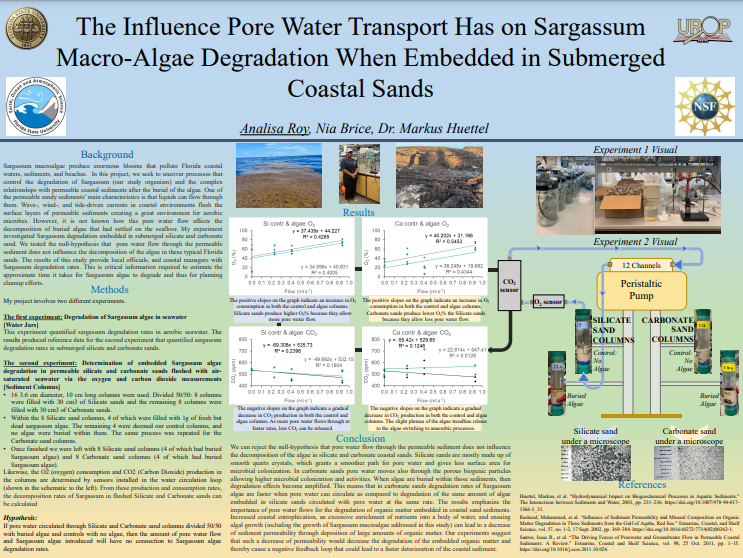Research Symposium
23rd annual Undergraduate Research Symposium, April 6, 2023
Analisa Roy Poster Session 1: 11:00 am - 12:00 pm/ Poster #54
BIO
Hello there, I am Analisa Roy. I have loved to get my hands dirty since I was a little girl, and that love has only blossomed as I aged. Growing up in Pennsylvania, I have always had a connection to the environment around me. I plan to combine my love of hands-on work and my passion for the environment into a long-lasting career surrounding Environmental Science. I'm still figuring out what I want to research, but so far, I like studying living organisms and their interactions with the environment around them.
The Influence Pore Water Transport has on Sargassum Macro-Algae Degradation when embedded in Submerged Coastal Sands
Authors: Analisa Roy, Dr. Markus HuettelStudent Major: Environment and Society
Mentor: Dr. Markus Huettel
Mentor's Department: Department of Earth, Ocean and Atmospheric Science Mentor's College: College of Arts and Sciences Co-Presenters:
Abstract
Large blooms of the macroalgae Sargassum threatens coastal environments in Florida as well as the Caribbean. For this project, we seek to quantify the influence pore water flow has on the degradation of Sargassum buried in submerged permeable marine sands. Ripples on these sands force water currents through the sediment and urge the transportation of oxygen into the bed and trapping of large amounts of red tide algae, bacteria, and other small particulate materials into the pore space of the sediments. This increases microbial decomposition processes in the seabed, including Sargassum degradation, and causes higher sedimentary oxygen consumption. As oxygen consumption increases, oxygen penetration depth into the sediments decreases while carbon dioxide release from the sand increases. Our project investigates Sargassum macro-algae degradation in fine silicate and carbonate sands. I focus on determining Sargassum algae decomposition rates within column reactors, simulating submerged sand, using oxygen consumption, and observing the resulting carbon dioxide production. Silicate sands are typical on colder beaches, dissolve slower, and have a white quartz-like appearance, while the biogenic carbonate sands are typical for subtropical and tropical environments. In an initial reference experiment testing Sargassum decomposition in seawater, we observed a strong correlation between Sargassum algae mass and oxygen consumption. We plan to share our findings with local officials that can use the information to determine whether the Sargassum algae should be removed from the nearshore environment to prevent harmful hypoxic conditions in the shallow water.
Keywords: Sargassum, Degradation, Transport, Algae, Sands


